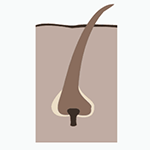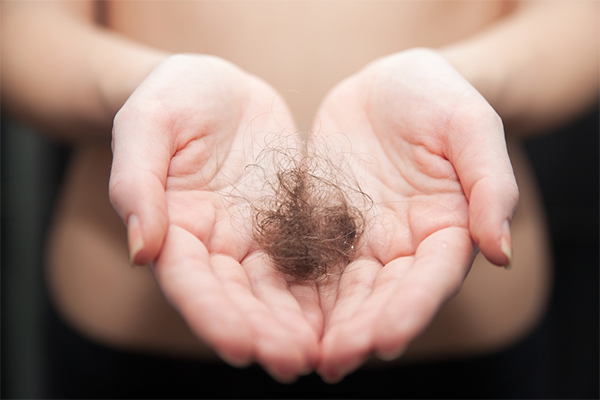What are the symptoms of hair loss?
It’s very common to see signs of hair loss in women. In fact, 40% of women have visible hair loss by the time they’re 40. Hair loss may take different forms, depending on the cause. You might notice overall thinning, female balding symptoms, or even the sudden loss of handfuls of hair.
Below are some early signs of hair loss linked to genetic or hereditary issues. If you notice any of these, Regaine® for Women could help.

A more prominent parting
A prominent parting is one of the early signs of hair loss. If your parting has begun to widen, and there doesn’t seem to be a way to cover it the way you used to, you may be experiencing hereditary hair loss.

More Hair On Your Pillow
We lose on average 30 to 150 hairs per day. If you see more than your usual amount of hair, this could also be a sign of hereditary hair loss.

More hair in your comb or brush
Having a few hairs in your comb or brush is normal. Seeing more than usual is among the main hereditary hair loss symptoms.

More hair in the shower drain
Having a large amount of hair in the drain after washing is a sign that you’re losing more than normal.
How can I tell if my hair is shedding more than normal?
You’ll know your hair and body better than anyone. So, it likely won’t take you too long to notice more hair-shedding than normal. You may spot that more hair is being lost when you shower, for example. Or you might find more strands of hair on your brushes. Even a quick look in the mirror might reveal some signs of hair loss. Meanwhile, the best way to know if you’re at risk of female pattern hair loss or baldness is by looking at your family history and any patterns of hair loss. Does the hair on the top and crown of your head appear particularly sparse? Does your family have a track record of hair loss? If so, you may be experiencing female pattern hair loss. Female pattern hair loss is genetic. So, your first step should be to look at other family members to see if their hair has thinned. On the flipside, if you’re experiencing rapid hair loss and have no family history, it’s best to check with your doctor to help understand the cause.
How does hereditary/female pattern hair loss progress?



Women with female pattern hair loss are less likely to go completely bald than men. But you may have a lot of thinning throughout your hair.
Female pattern hair loss normally starts with a gradual thinning of the parting. And it can sometimes be accompanied by the loss of hair at the front of the scalp, similar to male pattern hair loss.
Why does female pattern hair loss happen?
The most common reason for hair loss in women is linked to androgenetic alopecia (AGA) symptoms. This condition is also known as female pattern hair loss or hereditary hair loss.
Genetics, hormones, and age cause changes to your hair follicles, which may then lead to this condition.
Genetic hair loss normally occurs in women who are in their 50s or 60s. It often gets worse during menopause when estrogen reduces drastically. However, it may start earlier with women in their 30's or 40s.
Understanding the hair growth cycle
The hair growth cycle has three phases. It’s useful to understand the natural process taking place in your follicles during these phases. Then you can start taking steps to help your hair regrow.

Phase 1: Growth (or anagen)
For every hair on your head, the cycle begins with the growth phase, which lasts from 3 to 5 years. The hair grows at 1cm a month and usually about 85% of your hair is in the anagen phase.

Phase 2: Transitional (or catagen)
Eventually, the cells at the base of the hair stop multiplying. As a result, the hair stops growing before the resting phase begins. This catagen phase lasts about 2 to 3 weeks.

Phase 3: Resting (or telogen)
After the transitional phase, the hair follicles enter a 3-month resting phase. At the end of this, the hair is shed, and new hair replaces it. The growing cycle then starts again.
If you’re experiencing female pattern hair loss, you may still notice your hair growing. However, your follicles will continue to shrink, producing finer, shorter, and harder-to-see hair with each cycle until they’re no longer able to make new hair. That’s when female pattern hair loss symptoms can become more pronounced.
How to speak to healthcare professionals about women’s hair loss
It’s possible to consult healthcare professionals about the common signs of hair loss experienced by women. However, it’s only natural if you feel unsure what to say.
Here are some steps that could help before and during your consultation:

STEP 1: Create a simple diary to track your hair health
Jot down a list of out-of-the-ordinary experiences with your hair, such as more frequent and/or larger clumps of hair in the drain after showering or an increased number of strands on your pillow. Take these daily observations over a one- to two-month time period. These are all things you want to mention to your healthcare professional.

STEP 2: Feel free to bring the evidence
Write a list of all the self-diagnostic tools and tests you’ve used and the results from them. Bring them with you to your appointment. You may also bring photos of your scalp. Some women bring in clumps of hair in a plastic bag for their healthcare professional to examine. Don’t be shy. He or she is there to help you with any symptoms of hair loss.

Step 3: Discuss any related lifestyle habits or changes
Hair loss can be due to genetic factors. But remember that there are other causes of hair loss in women too. For example, long-term everyday stress could lead to hair loss symptoms. And in rarer cases, it could be down to a medical condition (perhaps related to your thyroid).

Step 4: Ask if further testing is needed
Expect your healthcare professional to ask further questions and to do a detailed review of your medical history. This might cover topics such as recent childbirth, surgeries or cancer treatments (chemotherapy or radiotherapy), and menopause. Plus, any familial history of hereditary androgenetic alopecia symptoms (e.g. genetic hair loss).
Signs of hair loss – key facts

The average scalp is covered with 100,000 hair follicles.
No new hair follicles are formed after birth. And as you age, follicles can stop producing new hair.
Female pattern hair loss mainly starts in women in their 50s and 60s, around the time of the menopause.
Left untreated, genetic hair loss will continue. Early treatment is key to preventing more hair loss.
Treat thinning hair at the earliest signs with Regaine® for Women to help regrow hair.
